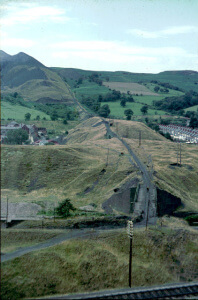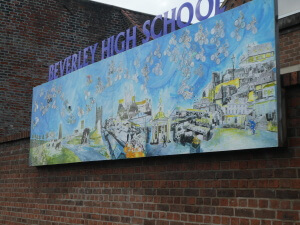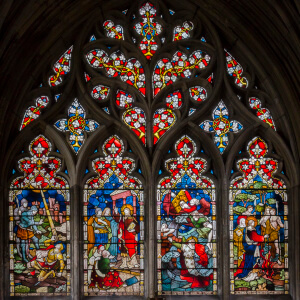I remember the Aberfan disaster. 21st October 1966. 240 children in school. 9.15 am.
An avalanche of coal waste slid and engulfed Pantglas Junior school, 116 children died. 28 adults, some occupants of nearby houses.
Aberfan Colliery Spoil Tramway, July 1964
Photo by John Thorn
I used to live in Charnock Richard, Lancashire and a mile or so behind our house was Welsh Whittle, a former pit. Along the main road, on the far side of Coppull, were slag heaps where we used to play – not on them, but around them. The air often smelled of sulphur. Coal was our fuel, and smog during damp winter months was frequent. We were sent home from school early – a treat!
For as long as I can remember, the image I associated with the loss of those children, was of my sister, a reception teacher, standing with her class along with teaching assistants. In my mind I substituted teachers I did not know with one I did.
The only problem with that memory is that my sister was not a teacher at that time. I was. Not in a primary school, but a secondary school in Chesterfield.
It was a tragic event and whether you were a teacher, a parent, whether you lived near slag heaps or not, you wouldn’t need anything other than the images relayed on television to highlight the shock. When did I do that? Why, I wonder, did I associate one event with another event?
Recently I returned to Beverley High School where I was a pupil for one year in the 1950s. I lived in a small town, Pocklington, and I and other friends travelled by train to and from school. I have a clear recollection of the four of us, taking it in turns to write a page or so of a novel during that journey. I remember the lined paper, that we wrote in pencil and that as the document grew, we held it together with a bulldog clip.
Mural outside school on 8th November 2019
The friend I keep in touch with, has no memory of writing that novel at all. From that experience grew my desire to be a novelist so it was important to me, but not to her.
Dr. Julia Shaw has researched the reliability of memory. She notes that family memories are frequently unreliable. The brain makes memory by building fictions so that the same incident will have a different story attached to it, by different family members. She shows that memories can be implanted. For example, the family may agree on a narrative. How that is done will depend on family members, one being more dominant than others.
The layout of Beverley High School was as I remembered, though the only part that I recognised was the panelled assembly hall. One clear memory I had was of reading the lesson one Christmas at Beverley Minster. Another mistaken memory. The school has only been doing that since 2000! How did that happen? I would have read the lesson at the school’s carol service, but at St. Mary’s Church, which is close to the school. It is a beautiful church, but not the Minster. So how did that memory become skewed? I don’t know. I can surmise I only attended the school for a year, the Minster being better known, that is what I remembered.
St Paul’s window, St Mary’s Church, Beverley
Jules & Jenny Lincoln August 2018 photo sent to Flickr
Dr. Shaw is reassuring about memory. She says we tend to remember what we pay attention to, and that by forgetting so much, we make room for more relevant – and in my case – more interesting stories!
References: Dr. Julia Shaw, The Memory Illusion, 2016
The photos are from entries to Wikipedia other than the one outside the school.



Recent Comments